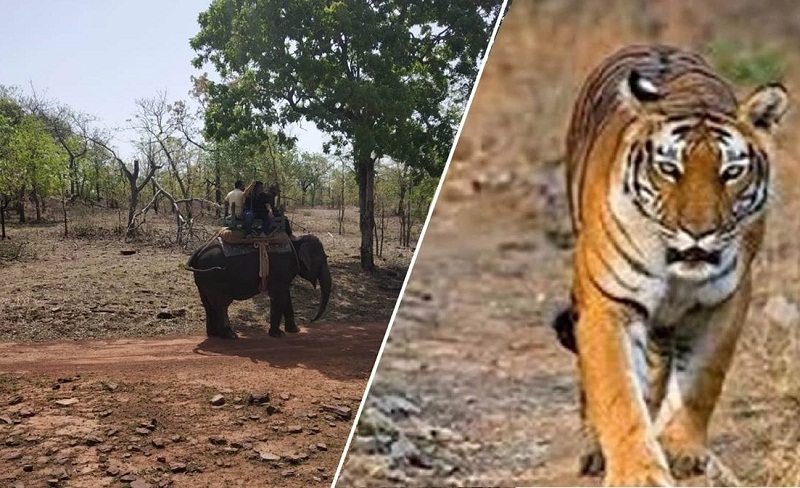Sagar/Bhopal, 20 September (HS). Madhya Pradesh's new and largest tiger reserve is celebrating its birthday on Friday. Madhya Pradesh, known as the Tiger State, has seven tiger reserves. The newest of which is Veerangana Rani Durgavati (Nauradehi) Tiger Reserve, whose notification was issued on 20 September 2022. With an area of 2339 sq km, it is the largest tiger reserve in MP. However, it was earlier known as Nauradehi Wildlife Sanctuary. Which was notified in 1975. But in view of the vast area here, tigress Radha and tiger Kishan were settled here in 2018 under the National Tiger Conservation Project and both of them increased the tiger family to 19 in just four years. After successful use as a habitat for tigers, NTCA declared it a tiger reserve on the proposal of the Madhya Pradesh government. The journey from Nauradehi Wildlife Sanctuary to the Tiger Reserve is very interesting and attractive for wildlife lovers.
Nauradehi Wildlife Sanctuary –
Nauradehi Wildlife Sanctuary, known as the largest wildlife sanctuary of Madhya Pradesh, was established in 1975. Madhya Pradesh's largest wildlife sanctuary with an area of 1197 sq km was spread over Sagar, Damoh and Narsinghpur districts. It was known as the natural habitat of the Indian wolf in Madhya Pradesh. The sanctuary is basically known as a place for wolf, leopard, bear, Nilgai, black deer population along with domestic and migratory birds. Apart from this, it also has a distinct identity as a natural wealth along with biodiversity. The water of two rivers here, Bamner and Byarma, reaches Ganga and Narmada. It is said that tigers also resided here, but after 2011 tigers were not seen here.
Earlier cheetahs were to be settled, but it became a Tiger Reserve –
Nauradehi Wildlife Sanctuary, which is known as the natural habitat of the Indian wolf with its vast area and abundance of herbivores, was first surveyed to settle African cheetahs. All the features were present here to make a habitat for cheetahs. But after the decision to settle African cheetahs in Kuno, it was decided to settle tigers here. For this, tigress Radha was brought from Kanha National Park and tiger Kishan from Bandhavgarh in May 2018 under the National Tiger Conservation Project. The pair of both increased the tiger population to 16 in just 4 years. After the formation of the Tiger Reserve, a male and a female tiger have been released on 27 March 2024 to settle tigers in Dongargaon Range of Narsinghpur district. After this pair of tigers was successfully released on the banks of Vyarma River near the displaced village Mahka of Dongargaon Range, the number of tigers is expected to increase further.
Research going on on Indian wolves –
Nauradehi was first identified as the only natural habitat of Indian wolves. This forest area was given the status of a wildlife sanctuary for the protection of Indian wolves. Research on wolves is being done here by SFRI (State Forest Research Institute), Jabalpur. In this, studies are being done on their natural habitat, lifestyle, behavior, food and breeding.
The natural habitat of the Indian vulture will be developed –
Nauradehi Tiger Reserve has also been chosen for the conservation of vultures, which are known as nature's cleaners. Currently, work is going on for captive breeding of vultures at Kerwa in Vanvihar Bhopal. The vulture babies born here will be settled in Nauradehi Tiger Reserve for natural development. For this, the Vulture Konch area of Dongargaon Range located in Narsinghpur district of Tiger Reserve has been identified. Vultures coming from Vanvihar Bhopal will be settled here and along with their conservation, their food habits, behavior and all activities will be studied.
A major destination for migratory birds
Nauradehi Tiger Reserve has a great identity as a shelter for domestic and migratory birds since the time of wildlife sanctuary. Many migratory birds come here from a distance of 3 thousand km in the winter season. Among them, birds like Brahmani Duck, Coot Glossy, Comb Duck, Patten Stork, Grey Heron, Himalayan Griffon are prominent. In fact, apart from Chhevla pond and Jagrasi Kheda pond of Nauradehi, migratory birds including storks, cranes, egrets, owls, kingfishers, vultures, lapwings, kites, eagles, patridges, quails, and pigeons also arrive in large numbers in the winter season around Bamner and Byarna rivers.
 look news india
look news india
